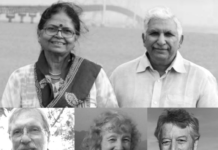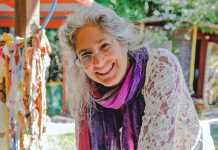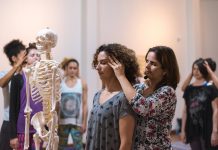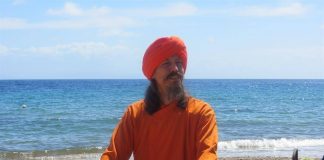Going back to Italy, after his first trip to India to see Baba, Kamaleshvara (Christian Franceschini), he received a task from Acarya Rainjitananda Avadhuta: to organize a speech, in one place where Ananda Marga still had no impact. He took dada’s request seriously and in two weeks he had organized one event in a nearby city. He rented a room for USD 50, he spreaded posters around town and in a foggy winter night, he took a train to complete his mission. However, no one showed up.
“At the beginning, I thought people were just late. But as time went by and nobody came, I was nervous and frustrated, since I had so much enthusiasm and hope that I could give something to the world, but the world was not prepared.” Feeling humiliated, and wondering if this would not be a test of Baba, he thought that at least he should use the occasion to do his sadhana. The result was unexpected and welcome. “I fell in samadhi and stayed for one hour on the spot,” he says.
Returning home late at night he still had to convince some police officers that he was not stoned. “I returned in a state of great bliss,” he says. History has taught him that there is always a good reason to always shout: “Even when you do not succeed outside, you will succeed within.” And in his case, success came in both ways. Today, years after that, Kamaleshavara accumulates in his trajectory three years as a LFT; two administrations like bhukti pradhan, in the city where he was born, in Bolzano, northern Italy; completed trainings such as tattvika, family acarya and, in 2018, senior acarya; besides having served in different positions, such as, for example, member of the Ananda Marga National Committee in Italy.
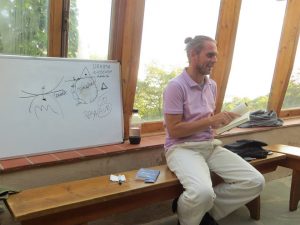 His merits come not only from his past roles, but also from the results of the services to which he contributed: building a master unit in Verona; creating of a tofu and seitan factory to generate funds for pracar; beginning the publications of Ananda Marga books in Italy; launch of the Yogic Academy and the Academy of Neo-Humanism, as part of the Gurukul department; and opening of a store and yoga center called Dharmica Point. As a yoga and meditation instructor, more than 12,000 adults have passed their classes, conferences, and retreats, as well as nearly 10,000 public school children. He has also published two books: “Tantric Biopsychology” and “Food of the Gods” (free translation), which together have sold more than 8,000 units and are available for purchase online at Amazon.
His merits come not only from his past roles, but also from the results of the services to which he contributed: building a master unit in Verona; creating of a tofu and seitan factory to generate funds for pracar; beginning the publications of Ananda Marga books in Italy; launch of the Yogic Academy and the Academy of Neo-Humanism, as part of the Gurukul department; and opening of a store and yoga center called Dharmica Point. As a yoga and meditation instructor, more than 12,000 adults have passed their classes, conferences, and retreats, as well as nearly 10,000 public school children. He has also published two books: “Tantric Biopsychology” and “Food of the Gods” (free translation), which together have sold more than 8,000 units and are available for purchase online at Amazon.
With so much history to tell us, Kamaleshvara ended up becoming a reference in how to make pracar, and currently gives training to other margiis who want to develop as pracarakas. “Training pracarakas is my favorite activity. We need to create human structures, committees, workshops, and also physical structures, such as jagrtiis. I promised Baba I would do this when I had personal contact. Every day I repeat that promise, and every day I fight to take your mission forward,” he says. For him, a good pracar depends on three main aspects: being an example, surrendering in the grace of the Guru and understanding the reality in which one wishes to act.
“My energy comes from the grace of Baba. And this comes, first, from the lifestyle. Following the 16 points as much as possible leave you energized and enthusiastic to work for Baba,” he says, referring to the first two aspects. About knowing the context in which the person will act, he reflects: “One thing is the idealism of dharma pracar and the other is the realism: what can you do in this social environment, in that historical moment? If you are far ahead of time, speaking too complicated, even if you are an example, it will be a good fit only in your mind. It will not succeed in the outer sphere. You need to blend in with people, understand their needs. You can go neither too fast nor too slow. If your pracar does not have rhythm, you can succeed from time to time, and then you will not have it anymore, because other people will be faster than you, presenting things better. New generations need something attractive, otherwise, it’s useless. Then, there is no dharma for all. “
As an example, Kamaleshvara mentions the practice of asanas, which in the past was done by a few people, in specific groups. “That has changed, and today you can create a school where young people want to go.” That is, the creation of a school like that, years ago, would have been precipitated, as well as not to create it now could make Ananda Marga outdated. “One dada once told me that in the 1980s Ananda Marga was 30 years ahead of society, and now it’s 30 years behind. Things are moving so fast! We were really ahead of time. Now, because of the internal situation of Ananda Marga, although there is a lot of projects flowing, we do not have a collective mind to understand the reality of the world and apply the dharma vision to the current situation. “
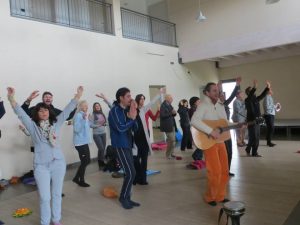 Kamaleshvara explains that there are two types of efficient pracar: face to face, focused in the person that needs to be inspired, and the second one focused in a wider public, through larger-scale activities such as courses, conferences, and retreats. “We need to organize events that attract and inspire people to the dharma, and then do the follow-up. What I did was to create a rhythm that ranged from the easiest event to the most difficult, and slowly people tuned in, making the process a success,” he says.
Kamaleshvara explains that there are two types of efficient pracar: face to face, focused in the person that needs to be inspired, and the second one focused in a wider public, through larger-scale activities such as courses, conferences, and retreats. “We need to organize events that attract and inspire people to the dharma, and then do the follow-up. What I did was to create a rhythm that ranged from the easiest event to the most difficult, and slowly people tuned in, making the process a success,” he says.
“You need to have a series of tools that make people follow fluidly. It’s like a river. Yoga classes, lectures, half-day seminars, weekend retreats for beginners, more intense retreats. I simply try to create the machine, as a system, where people enter in a flow with various events, according to their needs and capabilities.” For this system to work, it highlights the importance of creating a strong team. “To make an event for 200 people, you need to have 20 well-committed volunteers. So to succeed, you have to work hard to put together that team, which understands the spirit of pracar.”
Kamaleshvara’s clarity and strength impress, but as he stresses, they were characteristics shaped by spiritual practice. At 22, leading an unhealthy life, he entered a deep crisis and thought of suicide. During military service, questions about the meaning of his life did not leave his head. That’s when he got a book about yoga. “After finishing my military duties, I met a LFT on a train, because he saw me with the book. He invited me to a lecture by Dada Rainjitananda. Dada gave me namah mantra and I started to get rid of the bad habits I had. I was initiated in April 1987 and since then my life has accelerated so fast that in a few months I was in India at Ananda Nagar to see Baba,” he says.
 His visit to Baba was so powerful that on his return he changed his life completely: he began to dedicate himself more and more to sadhana and shortly thereafter he began LFT training. In 1989, he had personal contact with Baba. “He told me very nice things and he blessed me. On my return, I started working full time for the mission.” Today, at age 55, he is married to the tavvika Krisna Priya (Christina Terrible), with whom he has two children: Yogesh, age 17, and Chandra, age 14. “If you are married to a person who is also ideological, this is paradise. With children, there are times when they will follow you, but then they need to live their own experiences. But the principles of yama and nyama are there in their lives. If you are an example, that example will remain in their minds for life. “
His visit to Baba was so powerful that on his return he changed his life completely: he began to dedicate himself more and more to sadhana and shortly thereafter he began LFT training. In 1989, he had personal contact with Baba. “He told me very nice things and he blessed me. On my return, I started working full time for the mission.” Today, at age 55, he is married to the tavvika Krisna Priya (Christina Terrible), with whom he has two children: Yogesh, age 17, and Chandra, age 14. “If you are married to a person who is also ideological, this is paradise. With children, there are times when they will follow you, but then they need to live their own experiences. But the principles of yama and nyama are there in their lives. If you are an example, that example will remain in their minds for life. “
According to him, after empowering thousands of people and initiating hundreds, it is difficult to know how many of them have in fact become active margiis. “People may not even be practicing meditation, but they will surely say that it is important. I would say that few people remain at the top of the pracar activity, but many are supporting society – schools and institutions are opening up. The fact is that there are samskaras besides pseudo culture. But we are succeeding: the awareness of meditation in society is increasing. We just have to wait: the next generations will continue our work,” he explains.
Therefore, he argues so strongly that the community of Ananda Marga should focus on improving the quality of the work of dharma pracar. “We need to keep in mind that we must bring society to higher levels. It does not mean adapting everything and weakening ideology. The quality of pracarakas needs to improve. Dharma pracar depends on people, not on books. Books are good tools to strengthen, but in the end, it’s just the people, the pracarakas, who can make that mission grow, by His grace. “
Learn more about Kamalesvhara and his work:
By Gurucaran (Gustavo Prudente)
Picture by Lalita (Luara Balista)


